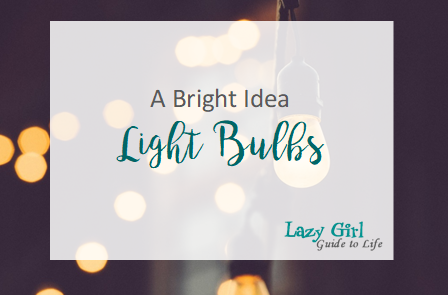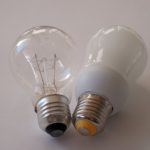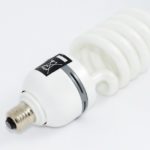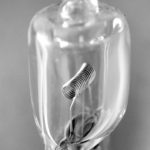Have you replaced incandescent light bulbs in your light fixtures? If you answered no, then you may be using incandescent technology that hasn’t changed much in 125 years!
That also means you are most likely paying too much on your energy bill. Better yet, you may not be enjoying the best lighting offered today. Since 2012, the incandescent bulb has become a thing of the past due to new lighting standards. What exactly does this mean?
Incandescent Light Bulbs
Historically, the traditional light bulb was purchased based on watts. For example, most fixtures used a 60 watt bulb. One might use a 100 watt bulb if more light was needed such as for reading. Think about it – we were purchasing bulbs based on the amount of energy to power the bulb instead of the actual amount of light emitted by the bulb. With traditional bulbs, 90% of the power required to give the desired brightness was emitted in heat instead of visible light. To better illustrate the differences, please view the chart below.
| Incandescent | Compact Fluorescent (CFL) | LED | |
| Life Span | 1,000 hours | 6,000 | 50,000 |
| Watts | 40 watts | 9 watts | 6 watts |
| Lumens | 400 | 320 | 300 |
| Heat Emitted | 56.6 BTUs per hour | 20.3 BTUs per hour | 2.3 BTUs per hour |
| Kilowatts of Electricity Used | 2,190 KWH per year | 531 KWH per year | 228 KWH per year |
| Annual Operating Cost | $219.06 per year | $53.06 per year | $22.76 per year |
Replacing Incandescent Light Bulbs
Consumers are no longer restricted to one particular type of light bulb. Even though the traditional incandescent is no longer available, we now have a larger selection to choose from such as halogen, fluorescent and compact fluorescent (CFL), and light-emitting diode (LED) lights. These three options have their pros and cons.
Of the three options, halogens look the most like the incandescent bulbs and is at least 25% more efficient. However, they have the lowest efficiency when compared to the other two options.
Fluorescent lighting has been with us for a while, but now we have compact fluorescent lights (CFLs). Compact fluorescent lights fit into traditional light sockets like incandescent bulbs. These bulbs do not turn on immediately, particularly in cooler environments. The colors seem dull and unnatural. Worse yet, these bulbs contain a small amount of mercury which is dangerous if broken and are difficult to dispose of when they burn out.
Light-emitting diode bulbs, while more expensive than other bulbs, give good lighting and last longer. Generally known as LEDs light bulbs, they can last up to 15 times longer an incandescent bulb. Perhaps most importantly, they do not contain mercury.
- Incandescent Bulb and LED Bulb
- Compact Fluorescent Bulb
- Halogen Bulb Up Close
Packaging Label
In 2012 the Federal Trade Commission (FTC) designed a new label for light bulb packaging. The label has brightness (measured in lumens), estimated yearly cost, lifespan, and light appearance (warm-cool) measured by correlated color temperature on the Kelvin scale.
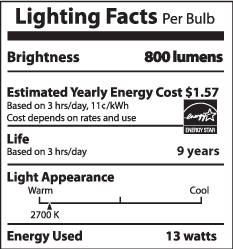
Lighting Facts Label
https://energy.gov/energysaver/lumens-and-lighting-facts-label
Light Up Your House
Consider replacing incandescent light bulbs throughout your house. While you will spend a little more upfront, you could save about $50 yearly just on your power bill by changing out 15 bulbs. An added perk – the new bulbs may seem expensive but given their longevity, the savings can be significant. Besides, who wants to change bulbs continuously?

